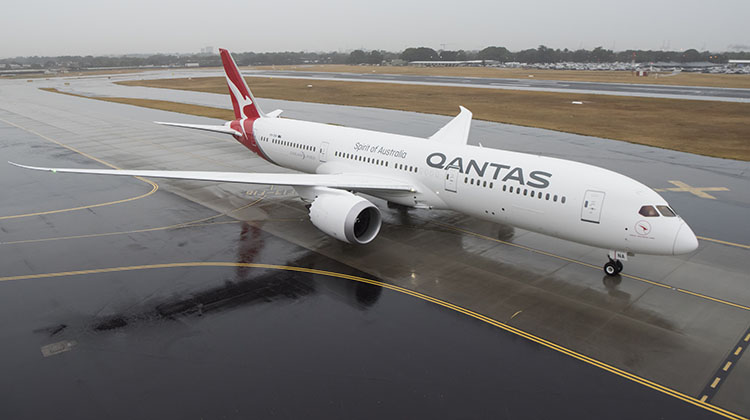
It’s been a long time coming. When the first Qantas 787-9 touched down in Sydney at the end of its delivery flight from Boeing’s Everett factory on October 20, almost 12 years had passed since the airline first placed its order for the 787 in 2005.
Qantas and Boeing have changed dramatically since the airline first announced its original order for 65 787s in December 2005, which at the time was the largest order placed to date for the aircraft. The 787 program itself suffered from a series of tumultuous development and production delays, while Qantas has ridden the highs and lows of record profits and record losses.
In all more than 600 787s have already been delivered to airlines around the world – including Qantas’s own Jetstar low-cost carrier subsidiary, which has been operating the shorter 787-8 variant since late 2013.
“I’m very proud,” Qantas Group chief executive Alan Joyce told Australian Aviation onboard the newly-accepted 787-9, registered VH-ZNA and named Great Southern Land, shortly after formally accepting the aircraft in a ceremony at the Future of Flight Aviation Center adjacent to Boeing’s Everett facility on October 16.
“You think of all the work and effort from the entire Qantas team that went into this, and seeing how good it looks in reality – I’ve seen the drawings, I’ve seen the designs – but seeing it in real life is just amazing.”
Acceptance of the aircraft marked a milestone day for Joyce, and a milestone day for Qantas, which, after a series of delays and deferrals, is only now taking delivery of its first 787, 10 years after the first 787 development aircraft was rolled out and six years after the first customer 787 delivery, to ANA, in September 2011.
“Everything went so smoothly today, having Iva Davies with us performing that song [Great Southern Land], seeing the new name on the aircraft, that was just so emotional and I think anybody that was in that room would have felt a bit of a tear coming on because it was amazing,” Joyce said.
“We’ve only changed the logo five times, and we’ve only done it when we think there’s a game-changing aircraft coming, and this one for us was a big occasion.”
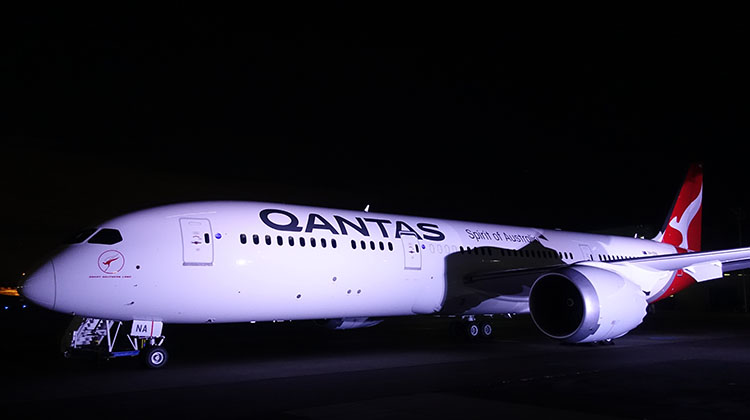
But it is how Qantas will operate the aircraft, pioneering nonstop flights between Australia and the UK from March next year, that will differentiate it from other operators of Boeing’s composite widebody twin.
“That range is special, and the reaction around the globe that that last frontier of aviation of linking these two continents together has got huge coverage, we’re seeing coverage everywhere and that shows you it has grabbed people’s imaginations,” Joyce said.
And even bigger things are to come for Qantas, which has announced Project Sunrise to acquire either the Boeing 777-8X or Airbus A350-900ULR to operate nonstop flights from the east coast of Australia to both New York and London.
“When we announced Project Sunrise in head office we had 3,000 people there, and you could see the excitement, the buzz that that created, because it does show that Qantas is back at the top of its game,” Joyce said.
“It’s got its mojo back, I think, and this [the 787] is an example of that.”
That was a theme that Joyce reiterated on the ground in Sydney shortly after VH-ZNA had landed on Australian soil for the first time.
“This in some way to me is a bit about the rebirth of Qantas,” Joyce told the 1,500 Qantas staff, industry guests and media who were inside the airline’s Hangar 96 at Sydney Airport on October 20.
“We can look so much forward to our second century stronger and more determined to be a world leader than we have ever been.”
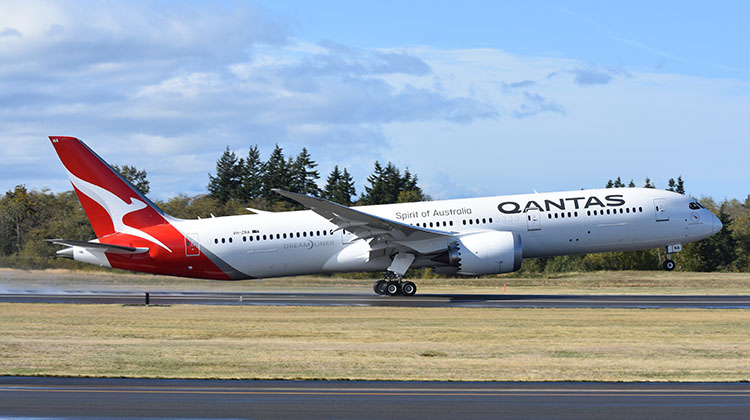
VH-ZNA had departed Paine Field, Everett on the morning of Tuesday October 17, with Qantas chief technical pilot Captain Alex Passerini, manager 787-9 introduction Captain Lisa Norman and project pilot – training First Officer Jim Eaglen on the flightdeck, landing in Honolulu five hours later.
The aircraft then spent the night in Honolulu before departing on the second leg of the journey to Australia just before midnight (local time) on Wednesday, touching down in a very wet Sydney 10 hours later.
VH-ZNA will be quickly followed by the next seven aircraft over the next 12 months through to November 2018. The second 787-9 is set for delivery to the airline in early December (allowing Qantas to begin Melbourne-LA flights), and it will be followed by aircraft three in January and aircraft four in mid-March, then Qantas International chief executive Gareth Evans confirmed ahead of VH-ZNA’s formal handover.
Those four aircraft will allow Qantas to launch its Perth-London flights, pioneering nonstop commercial airline services between Australia and Europe for the first time.
“The four aircraft are actually patterned together so that the aircraft run Los Angeles-Melbourne-Perth-London in a sort of smile pattern,” Evans told media at Boeing’s Everett plant on October 15.
“It starts to help us build a western hub, and potentially we can add additional services to Europe through that hub in the future, potentially a Brisbane-Perth-Paris or a Sydney-Perth-Paris, building a hub and hitting those key European hubs directly.”
But Qantas has already announced that its next four 787s will be based in Brisbane, two of which will be used to replace Boeing 747-400s on the airline’s current Brisbane-LA-New York rotation. That will then leave the remaining two aircraft for future route opportunities.
“The range capability that this technology delivers will enable us to hit new destinations, potentially things like Brisbane-Chicago,” Evans said.
“This new technology, and the technology potentially to come, will revolutionise our international network. These are aircraft that are made for Qantas and we can do unique things with these aircraft that other airlines, because of their geography, perhaps will not, or don’t need to.
“Because of their size, these aircraft are going to be great for our Asian network as well – point-to-point travel into Asia, 236 seats so there’s great opportunity and potential going forward for us to use this wonderfully flexible and efficient aircraft right around our network.”
And future 787 orders could be for the largest 787-10, or, probably less likely, the shorter 787-8, joining the 11 -8s that are already in service with Jetstar.
“This is a flexible order stream, so with appropriate notice we could move from a -9 to an -8 to a -10 and so it’s a great level of flexibility that we have to manage our fleet plan together with Boeing,” Evans said.
In all the first eight 787s will allow Qantas to replace its five oldest 747s.
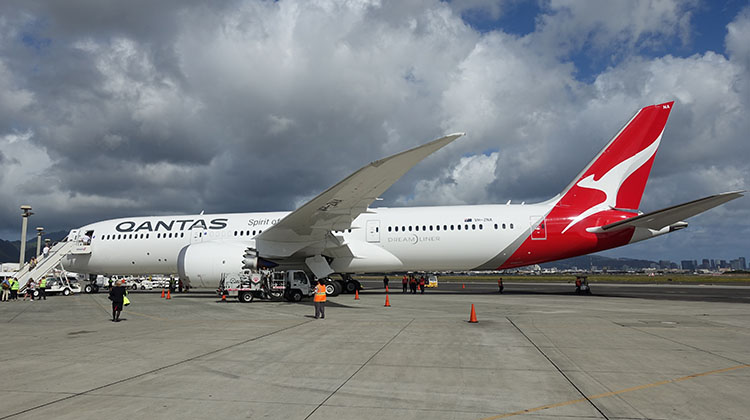
Beyond that Qantas holds options and purchase rights on a further 45 787s, but Joyce says a decision on exercising some of those options won’t be taken until some point next year after seeing how the first aircraft perform in service.
“There will be a gap, we do need to bed down the [787] operation, make sure that everything is working,” Joyce said. “We do have flexibility with Boeing and there is availability [of delivery slots] at the end of 2019, 2020 onwards.”
It’s a relatively conservative approach to introducing the aircraft into service, but nonetheless it seems likely the ultimate Qantas fleet will end up as much larger than eight units.
Boeing’s latest Current Market Outlook forecasts airlines in Oceania (Australia and New Zealand) will require 150 medium-category widebody airliners of the 787 size over the next 20 years. Given Qantas is by far the largest of the three major airline groups in Australasia, that suggests a much larger Qantas 787 fleet in the longer term.
Joyce hinted a 787 fleet in the “teens” was likely at the minimum.
“We’ve always said that the eight aircraft that we have as an example of the 787s is a minimum,” he said. “We’d like to have a lot more than that. You actually do have to get in the teens, I think, for the aircraft to have a minimum flyable level of operation. Eventually, we will be ordering more of the 787s because we think it’s a great aircraft. It’s just at what pace of time that we do that.”
How and where Qantas deploys the 787 will also determine how many 787s it eventually acquires. One point Joyce stressed was that it was unlikely the 787-9 would be deployed on domestic routes – at least after VH-ZNA finishes its domestic flying in November and December while crews build currency and experience on the type.
For the domestic mission, especially on east coast trunk routes, the 787, like the A330, is too heavy, Joyce said.
“With the 787s, as with the 330s, we find that they are pretty powerful over‑specced aircraft for flying Melbourne to Sydney, so the economics do not work on those legs. What we have done is we’ve added more and more frequencies, which the market likes with 737s, and that has dramatically improved the economics of our domestic operation.
Instead Joyce revealed Qantas is looking very closely at Boeing’s proposed New Mid-sized Airplane (NMA) project to develop a new small widebody airliner.
“That’s why this mid-range aircraft is actually very interesting, because while there are slots at Sydney today, [over time it will be] completely full. We know that. But I think our forecast has by 2023, we’re thinking we’ll be full and therefore having bigger aircraft that can do those routes, I think is going to be key.”
Qantas is “very keen” on the prospects of the NMA, which the Qantas boss described as “a fantastic transcontinental and maybe [to] Asia aircraft”.
“The economics of that on paper look good,” Joyce said.
“We think there is a bit of gap… and Boeing thinks that as well,” Joyce said.
“This is where Qantas is probably unique because we want ultra long-range but we also have a huge domestic network, so you want an aircraft unlike the 787s and the A330s which are designed for long range and are heavier than what we want [for domestic flying] so the economics on domestic takes a hit, whereas this aircraft could be the perfect vehicle east-west, into South-East Asia and leveraging the [available] slots [at Sydney].
“And that is something that we are very keen on and are working through.”
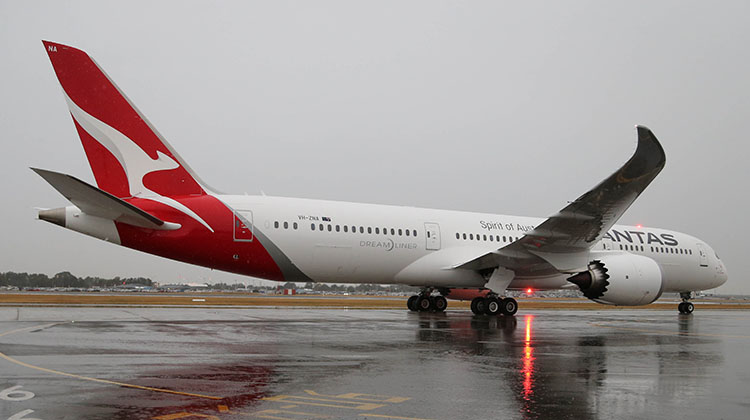
And at the other end of the size scale, Qantas’s likely 787 order book is likely to be affected by the decision it makes for its ‘Project Sunrise’ requirement for an ultra long‑range aircraft, a development of either Boeing’s 777-8X or the Airbus A350‑900ULR, capable of operating nonstop between the east coast of Australia to London and New York.
Joyce says the existing Airbus and Boeing designs come close in terms of meeting the mission of a full passenger and cargo payload in both directions for London and New York from Australia’s east coast capitals of Brisbane, Melbourne and Sydney, as well as points in South America and South Africa.
“We think this challenge is feasible,” Joyce said.
“From our perspective, the critical thing is to get it with full payload. We want the full capability of the 777-8X on those routes with full passenger payload and full freight payload.”
While most of the initial focus when Project Sunrise was publicly launched in August was on London Heathrow (9,188nm from Sydney) and New York JFK (8,647nm), Qantas has also earmarked Rio de Janeiro in Brazil (7,312nm) and Cape Town (5,946nm) in South Africa as new frontiers for nonstop service.
And Joyce has publicly stated a desire to mount nonstop flights to other European points beyond London, such as Paris and an unspecified city in Germany.
“We’d love to be able to fly directly into Brazil, into Rio and we’d love to be able to fly directly into Cape Town,” Joyce said.
“Existing technology doesn’t allow us to do that. While the aircraft is close, it’s not quite there.”
Currently, the world’s longest route by distance is Qatar Airways’ Doha-Auckland service at 7,848nm, operated by Boeing 777-200LR equipment.
While it is true the 777-8X and A350-900ULR are capable of operating those Project Sunrise routes, the range versus payload specifications were not quite where Qantas believed they needed to be for either airframes to ensure the routes were economically viable.
The Boeing website lists the 777‑8X as having a range of 8,700nm and a passenger capacity of 350-375 passengers. The aircraft is expected to enter service in 2022.
However, the final specifications will only be known after further development of the aircraft design and an analysis of its General Electric GE9X engines.
Meanwhile, Airbus has not published specific technical data on the A350-900ULR, stating only the long- range variant was capable of flying 19 hours and carrying up to 165,000 litres of fuel. By comparison, the standard A350-900 has a range of 8,100nm and could take on 141,000 litres of fuel.
Although Qantas has not spelled out its specific requirements for passenger count and cargo, preferring only to say a full payload was the target, Joyce did offer one little detail about the potential cabin layout.
“Our ideal is to have all of our classes on board the aircraft,” he said.
“We know there is a certain demand for business, we know there is a certain demand for premium economy. And we know we have to have economy on the aircraft to make the economics work. The prices will be competitive.”
It’s likely Qantas will look to acquire more than the half-a-dozen or so ultra long-haul jets it would need for daily Sydney-London and Sydney-New York flights, as both aircraft types would open up a range of other nonstop options – Melbourne and Brisbane to London nonstops, Sydney nonstop to Chicago, Toronto and even Rio de Janiero. (Sydney-Rio is ‘only’ 7,312nm, but the great circle route crosses over the top of Antarctica.)
And beyond that, whichever new type Qantas selects under Project Sunrise – the name is a nod to the ‘Double Sunrise’ flights Qantas operated nonstop between Perth and Sri Lanka using Catalinas in WW2 – it seems likely to form part of a larger subfleet.
Both the A350 and 777X families present interesting options for Qantas as it looks to replace its widebody fleet, the 777-9X could replace A380s and 747‑400ERs for example, the A350‑900 could replace A330s, if the 787-9 is not already pencilled in for that.
So with major fleet decisions looming at the top and bottom ends of the 787’s range and seating capacities it’s hard to see Qantas taking up all 45 orders, options and purchase rights. But CAPA – Centre for Aviation’s senior analyst Will Horton makes the point that the original Qantas Group 787 operator, Jetstar, could be the natural home for more of the type.
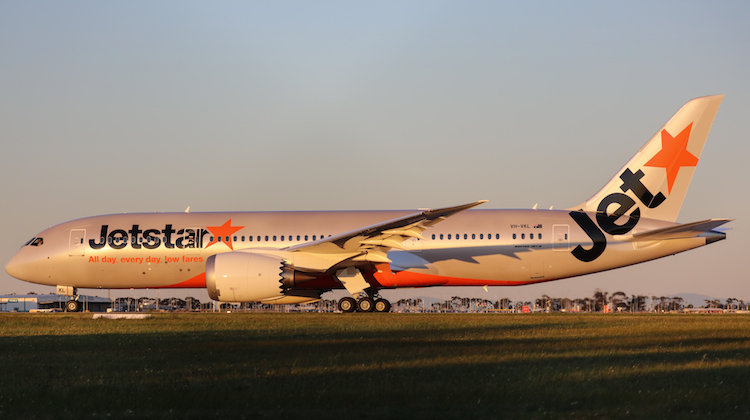
“Jetstar operates 11 787-8s and would benefit from a larger fleet, including -9s, to allow it to finally seize opportunities it has had to wait on while competitors – notably Scoot and AirAsia X have grown their widebody fleets,” Horton wrote in late October.
But, notes Horton, the Qantas Group’s target of a return of 10 per cent on invested capital would “significantly restrict” the capital outlays available for any Jetstar (or indeed Qantas mainline) 787 follow-up order.
Nonetheless, there is a small window of opportunity between when the last of the current eight 787-9s on order for Qantas are delivered in 2019 and the first Project Sunrise aircraft enters service in 2022 for capital allocation for new 787 orders, Horton wrote.
“Additional 787s offer substantial benefits for the new operator Qantas and original group operator Jetstar,” he concluded.
One of those tasked with maximising the benefits that the 787 brings to “new operator” Qantas is Phillip Capps, head of customer product and service development. As such Capps had carriage for designing the Qantas 787’s cabin configuration.
“For us the challenge was a multiple one, was to really get the configuration right so we need to get a mix of the different cabins that maximises our profit,” Capps said in an interview during VH-ZNA’s delivery flight.
“Once we’re clear on that then a big consideration was to try and fit as many seats in while still delivering on the core elements the customers need, so space, privacy, seat width, seat comfort and it ends up being quite a mathematical process to try and optimise both of those different profit maximising and also customer elements.”
The configuration Qantas landed upon to maximise profitability was a premium-heavy 236-seat layout, seating 42 in business class in a 1-2-1 configuration offering direct aisle access for every passenger, 28 in premium economy laid out 2-3-2 across and 166 in economy in a 3-3-3 layout with 32in seat pitch and 17.2in seat width.
“Then the other really big important thing for us was to minimise weight and so we’ve looked at everything from seat structures through to seat cushioning, the materials we make the seat out of and the fabrics on the backs to the leathers on the headrest, the style of seat belts … the type of lift flaps, sort of seat belt mechanisms that we use, to maximise safety but also minimise weight.”
Weight is critical in any aircraft design, but especially so when you’re planning to operate nonstop between Australia and the UK.
“The target that we had across all the different areas that have worked on the aircraft was to make sure that we could operate maximum passenger load … Perth to London and also Melbourne to Dallas non-stop, Melbourne to Dallas being a route that we don’t currently fly but we could theoretically in the future, I want to make sure that we’re future-proofed for that.”
Indeed in many ways the 787 itself, and what follows it under Project Sunrise, are about future-proofing Qantas’s international operations.
As Qantas looks to its future it is clearly planning to go the distance.
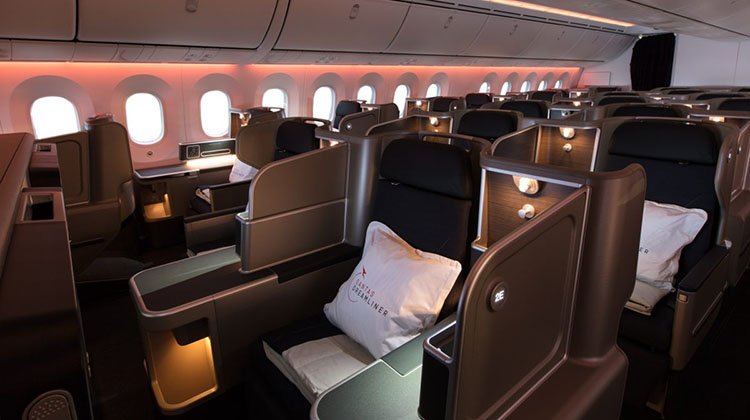
This feature story first appeared in the December 2017 issue of Australian Aviation.










